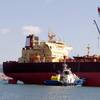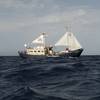War is upon us. One cannot help but think that war and its impact upon our everyday lives will be with us, both directly and indirectly, for years to come. The US coalition forces will persevere and, in the end, prevail. The costs must be measured in human lives as well as dollars. Our world has forever changed and will continue to evolve in the aftermath of the war into the unforeseeable future.
Security is part of the cost of living in this new, post-9/11 world.
The security matrix being imposed upon the maritime community by the International Maritime Organization (IMO) and the USCG, in the form of the Maritime Transportation Security Act of 2002 (MTSA), is complex and at least somewhat baffling. The mystery will no doubt continue to keep us hunting down answers, at least until the Interim Regulations are published. This will most probably occur sometime in June 2003. Final Regulations are supposed to be published in November of this year. Many of us find the thought of meaningful Final Regulations being released by November exceedingly difficult to believe. The new Interim Regulations will specifically concern the implementation of the MTSA and IMO's International Ship and Port Facility Security (ISPS) Code and the Automatic Identification System (AIS) carriage requirements of IMO and MTSA.
The USCG will give the maritime industry 3 to 6 months from the publication of the Interim Regulations to prepare the required assessments, perform any necessary plant and personnel modifications, and develop security and incident response plans. To continue to operate, a vessel or facility will need to have approved security and response plans within one year of publication of the Interim Regulations.
The ISPS Code and AIS carriage requirement will go into force internationally in July, 2004. Vessel operators with ships that call on US ports and, of course, those of us who live here will necessarily have to comply with the USCG's regulations and their interpretation of the ISPS Code.
The ISPS Code has been published for some time, but leaves the details of compliance up to the individual flag state (in this case, the USCG for us). On the face of it, the ISPS looks quite clear, but the details of interpretation for US vessels and facilities in the US will remain indeterminate until the regulations are published.
The Coast Guard has let it be known that foreign vessels will probably be able to enter the US using nothing more than the ISPS Code Certificates issued under the authority of their respective flag state.
Or, maybe not.
One must remember that under the Oil Pollution Act of 1990 (OPA '90), foreign tankers entering US waters had to have Vessel Response Plans which had been specifically approved by the USCG.
On the surface, the USCG seems to be making an effort to avoid that sort of unilateral application of US standards with respect to security. It is not at all clear whether or not they will succeed. In part, this is because of the vagueness and lack of specific details surrounding the application of the ISPS Code and in part due to a general reluctance of the US to accept IMO Certificates issued by an Islamic fundamentalist state sworn to destroy us. It gives one pause to consider that a vessel under the flag of a possibly hostile nation, and/or with a suspicious or dubious crew, might be able to enter the US based upon the Security Plan, risk assessments, and ISPS Certificates issued by the vessel's home government.
Compliance is even more complex for domestic vessels and facilities. The Coast Guard has very clearly stated that US flag vessels, and facilities located in the US, must comply with a domesticated version of the ISPS. What does this mean? No one outside the USCG will know for sure until the regulations are published, although many of us think we have a handle on it and are in the process of making educated guesses.
Domestic Application
It is not absolutely clear to which vessels and facilities the domestic version of the ISPS will apply, as the final lists of cargoes are still evolving. These will no doubt include vessels that carry more than 149 passengers and facilities that serve them, inspected vessels, any regulated dangerous cargo (those cargoes regulated by 33 CFR 126, 127 or 154 and the facilities that serve them) and vessels and facilities that handle Certain Dangerous Cargoes (CDCs). These CDCs include cargos that require special handling permits such as certain radioactive, poisons and oxidizers, as well as certain particularly nasty chemicals or pressurized flammable gasses such as chlorine, propane, anhydrous ammonia, propylene, vinyl chloride and a number of others. It appears probably that the security requirements will only be applied to inspected vessels. Dry bulk river barges that carry dry bulk dangerous cargoes (authorized to be carried in uninspected inland barges) will probably be left out of the new security requirements.
The complete regulatory scheme for US facilities and domestic vessels are still evolving. Compliance measures should not be initiated based upon the voluntary guidelines published as Navigation & Vessel Inspection Circulars (NVICs). There is no question that NVIC 10-02 for vessels was modified by the publication of NVIC 11-02 for facilities, and that subsequent NVIC publications, including the Interim Regulations, may further modify both of these in subtle yet critical ways. While general cognizance of the ISPS Code and terrorism (in particular) is a wonderful idea, compliance initiatives should not be kicked off until the Interim Regulations are published.
In other words: Until the requirements are established, one should not rush into attempting to bring vessels and facilities into full compliance because no one knows exactly what that means in the US, and will not know until the regulations are published.
Charley Havnen is a Commander USCG Ret. His organization can help you with your vessel construction project, regulatory problems, vessel manning issues, procedure manuals, accident analysis or serve as an expert witness. His organization can do what you can't or don't want to do, and are online at http://www.havnengroup.com. He can also be reached by contacting the Havnen Group in New Orleans: (800) 493-3883 or (504) 394-8933, fax: (504) 394-8869.
Sponsored Content
LR - Fit for 55: Managing compliance and optimising operations

Use Roxtec seals, services and software

Subscribe for
Maritime Reporter E-News
Maritime Reporter E-News is the maritime industry's largest circulation and most authoritative ENews Service, delivered to your Email five times per week









